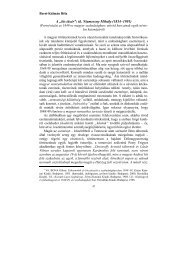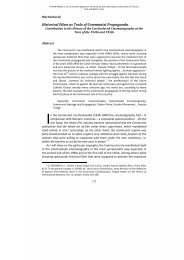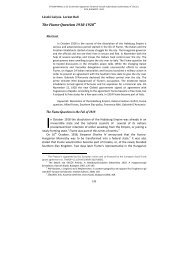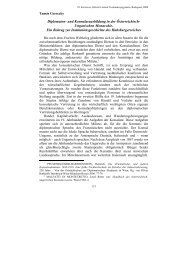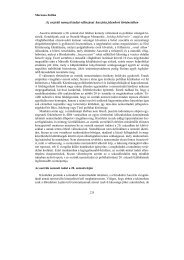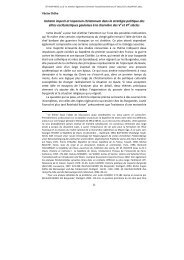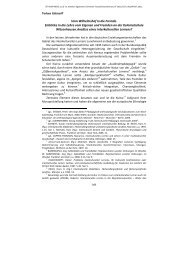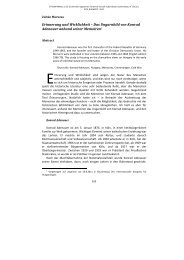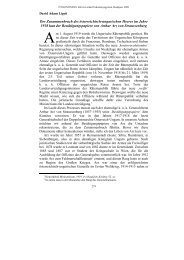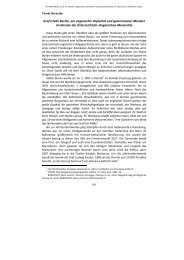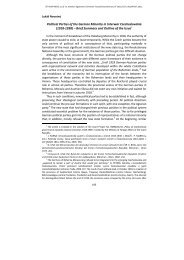The Molotov-Ribbentrop Pact - ELTE BTK Történelem Szakos Portál
The Molotov-Ribbentrop Pact - ELTE BTK Történelem Szakos Portál
The Molotov-Ribbentrop Pact - ELTE BTK Történelem Szakos Portál
You also want an ePaper? Increase the reach of your titles
YUMPU automatically turns print PDFs into web optimized ePapers that Google loves.
(„Münchner Abkommen”) and the imminent outbreak of World War II it was<br />
getting more and more difficult for Jewish refugees to get abroad, because most<br />
of the states closed their doors for them. 61<br />
In October 1939 Eichmann was transferred to Berlin and SS-<br />
Sturmbannführer Hans Günther took over the office in Prague, which for<br />
Heydrich was of secondary importance, because for him the expulsion from the<br />
Jews of the old Reich („Altreich”) had top priority. For this purpose he already<br />
had readily plans available. 62<br />
<strong>The</strong>se plans, and here my work finally connects to our unifying topic, the<br />
<strong>Molotov</strong>-<strong>Ribbentrop</strong> pact, originated on the assumption to be, after the<br />
conquest and division of Poland which was sealed by this pact, in possession of<br />
territories, Central European Jews could be forcibly send to. <strong>The</strong> domination of<br />
the polish territories meant a sharp rise of Jews, living under direct German<br />
rule. <strong>The</strong>ir number increased nearly sixfold to over 2 million. 63<br />
This plans, which would soon go under the name „Nisko project”, were<br />
from the very beginning on plans that were about the expulsion of Jews, and<br />
not about a settlement program of Eichmann, as it is often be said. Safrian<br />
speaks generally assumed that the invasion of Poland was accompanied by an<br />
increase in racist politics. This was also reflected in the demand of Hitler to<br />
carry out an expulsion and liquidation program („Vertreibungs- und<br />
Liquidierungsprogramm”) in the occupied territories of Poland. A so-called<br />
„völkisch-politsche Flurbereinigung” („ethnic-political clearing-up of land”),<br />
which was, according to Heydrich directed against the „Judaism, Intelligence,<br />
Clergy and Nobility” of Poland. 64<br />
Up to Hitler’s intention Poland should also have been divided into three<br />
stripes 65 . All Jews should be held in the territory between Vistula and Bug 66 ,<br />
and in this way a „Jewish reservation” should arise according to the ideas of<br />
Hitler, Himmler, Heydrich and also Eichmann. 67 Such a „Jewish reservation”<br />
in the so-called „Generalgouvernement” could at this stage, according to<br />
Safrian, have been understood as the „Endziel” („ultimate goal”).<br />
In the SD-Main Office, however, deportations of Jews into the<br />
„Geralgouvernement” and a further „removal” across the German-Soviet<br />
border were approved by Hitler on the 21 st of September 1939, in the presence<br />
61<br />
YĀḤÎL, Lenî: Die Shoa. Überlebenskampf und Vernichtung der europäischen Juden.<br />
München, 1988. 176-179.<br />
62<br />
KNOPP: Helfer. 39. LEGENSTEIN, Roland: Adolf Eichmann - der Schreibtischtäter.<br />
Koordinator der „Endlösung”. Dipl.-Arb., Wien, 2002. 43-46.<br />
63<br />
RIPPER, Torsten: Vom Vorurteil zur Vernichtung. Hitler und die „Endlösung der<br />
Judenfrage”. Schwalbach/Ts., 2001. 40.<br />
64<br />
SAFRIAN, Hans: Eichmann’s Men. 48.<br />
65<br />
After Poland had been split on the 28th of September 1939 between the Soviet Union and<br />
Hitler’s Germany, they agreed on the relocation of ethnic Germans from the Soviet-occupied zone.<br />
66<br />
DIETRICH, Adam Uwe: Judenpolitik im Dritten Reich. Düsseldorf, 1972. 249.<br />
67<br />
IRMTRUD, Wojak: Eichmanns Memoiren. Ein kritischer Essay. Frankfurt/M. 2001. 104-107.<br />
88



